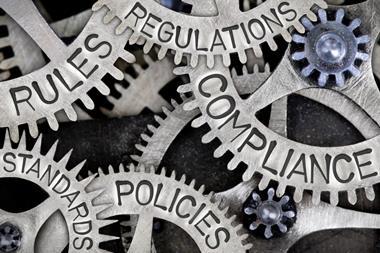The factors that drive underwriters are changing, and corporate insurance buyers who adapt will make their companies a more attractive risk, says Raj Ahuja
How well do you know your insurer? At the recent AIRMIC conference, the outgoing chair Julia Graham repeated Darwin’s mantra that the most successful species are those that adapt to new environments. The underwriting environment is evolving rapidly, and some risk managers are adapting more readily than others.
It is only natural for corporate buyers to expect their underwriters to understand their organisations – and rightly so. A complex business with international interests requires a bespoke insurance programme, and that demands the active involvement of both underwriter and broker. It is all part of the service.
There is justice, too, in the frequently heard refrain that underwriters should reward good risk management. By and large, insurers have got the message, though no doubt some buyers feel they could do more.
Often overlooked in all this is the importance of the two-way process. Insurers have needs, too. Clients who understand them will get a better deal and have a wider choice of cover provider.
The changing dynamics of underwritingThe factors that influence underwriters have evolved steadily over the past five or so years, subtly changing the crucial underwriter-buyer interface. At the heart of these changes lies an ever increasing appetite for data that is detailed, timely and consistently presented.
The speed of change is, if anything, quickening under pressure from Solvency II, the ratings agencies, increasingly proactive shareholders and, most recently, the recession. Risk managers who understand these developments will, quite simply, be in a stronger bargaining position. They will also, incidentally, be better placed to use their own retentions, including captives, in a more capital-efficient manner.
A good place to start is with enterprise risk management (ERM). This is one of the big talking points among risk managers and insurers alike, especially the issue of how to turn a theoretical concept into concrete results. Yet ERM is interpreted differently by different people. To a re/insurer it may be largely numbers-driven while, for a manufacturing or retailing business other much wider factors such as business continuity and reputation will likely play a dominant part.
When it comes to commercial big-ticket insurance, the most successful buyer-underwriter relationships will be those where both parties understand each other’s approach to ERM. For the risk manager, that means grasping the changing way in which re/insurers rate their risks.
There are two reasons why understanding this aspect of the business is beneficial to commercial buyers. Firstly, it provides a useful insight into underwriters’ thought processes. Secondly, applying the same processes to their own organisations will give them a better understanding of their risk profiles and exposures, and the ability to identify the most cost-effective steps to acquire greater stability. This is especially desirable at a time when many insurance companies have let rates fall, resulting in immediate pressure for premium increases.
These benefits apply whether or not there is a captive involved, and to negotiations with reinsurers as well as insurers. They apply to all main classes of business, including property, liability and motor.
How ERM changes the arithmetic
Until the end of the 1990s, most underwriters’ rating strategies could be summarised, admittedly with some degree of oversimplification, by the following formula:
Old Price Allow for insured’s recent loss experience Allow for market trends = New Price
This ‘suck it and see’ approach goes a long way towards explaining why so many risk carriers once haemorrhaged money by under-pricing their products. Put simply, this approach is out-of-date and only a few insurers cling to it. Yet it remains embedded in the mindset of many buyers, contributing to the misunderstandings that occur around the negotiating table.
The professional approach to underwriting begins with the re/insurers creating ERM models of their businesses. This practice is similar in principle, though not identical to, the ERM practised within corporates: both share an holistic approach to risk.
The exercise involves identifying and quantifying all the risks inherent in the re/insurance company (including those that are not underwriting or investment-related). It is then possible to create simulation models that enable you to feed in any number of possible real-life scenarios and measure their potential financial consequences. Managers can use this information to determine accurate underwriting guidelines for all their classes, consistent with their return-on-capital targets. (The modelling has many wider strategic advantages as well, but they are outside the article’s scope.)
The growing importance of data
“Presenting risks as a compact, neat and easily digested product could increase the number of potential cover providers
As you would expect, modelling is heavily data-driven. Acquiring accurate and meaningful data, both historic and predictive, is a large part of the challenge, as is adjusting this data to make it relevant. The answers are only as good as the quality and consistency of the input, and there are now powerful software products to assist.
What does this mean for corporate insurance buyers? Your personal relationships, although still important, are just one part of the jigsaw. Underwriters simply do not have the room for manoeuvre that they once had; your terms will have to comply broadly with the rating structure as set out by the re/insurer and their need for a satisfactory long-term return on capital.
Of course, the ability to demonstrate good risk management and internal controls will have a bearing, but re/insurers generally believe they have already responded in these areas; they will require evidence of further and material changes. Another way to help your cause is to provide sufficient detailed and reliable data in the format that the models require. The old practice of withholding information until the last minute in order to get a better price was always highly dubious and would now be decidedly counter-productive.
The more vague the information, the more the underwriter is likely to take a cautious view: in other words, to increase your premiums. Many insurance buyers believe they already provide the necessary data, but underwriters often see it differently. Their appetite for information continues to grow with, for example, a desire for detailed geographical modelling and knowledge of proximity to crime hotspots or hazards, such as petrochemical manufacturing and storage facilities.
This is one reason why large corporates should consider creating risk models similar to those of their re/insurers. Doing so will enable them to anticipate how their underwriters will respond to a particular package and what incentives or concessions might produce the most favourable reaction. You will get an early indication of what is causing the premium to be so high, allowing you time to provide solutions.
For the very largest firms, which would otherwise have a very limited choice of insurers capable of meeting their capacity needs, presenting their risks as a compact, neat and easily digested product could also increase the number of potential cover providers.
Another important implication for buyers is that, where they have been largely forced to accept much higher deductibles, many corporates retain huge amounts of non-catastrophic risk, either directly or through their captives. This relates to both property and casualty. Whilst this may be a sign of good and confident management, it increases the inherent uncertainty and generates a lack of predictability for the profit and loss. That is a second advantage to creating your own risk model; it will enable you to manage and predict your residual (uninsured) risk effectively.
A practical example
Let us turn now from the theoretical to the specific: a retailer, in figure 1, with outlets across North America and physical assets worth slightly more than $1.25bn, employing around 5,000 staff and running some 300 cars and commercial vehicles. Reinsurance is arranged via a captive and, after the 2005 storms, only kicks in at $1m for all perils for property/business interruption. All other classes have each and every loss deductibles of $200,000.
The risk manager has in the past sought to estimate likely losses to within a margin for error of $0.5m, but the new structure makes this a considerably more difficult challenge. He creates a model to help him to quantify his risk and give him a clearer idea of his retained exposures. A key output is shown in figure 2, where the buyers can really consider the degree of risk retained. The higher percentiles prompt a review of risk carried on the balance sheet and further, more complex, risk structures are needed.
This is the sort of thing that a growing number of corporates are doing, especially in North America and Europe, now that it has become a lot simpler. The secret is to choose a model or modelling software that allows maximum flexibility, and to start with a relatively limited and straightforward project. Once successfully completed and the lessons learnt, you can then progress to something more ambitious and wide-ranging. ‘Fit for purpose’ is always a key consideration.
Increased confidence
One of the outcomes of this particular model is that, although the different classes may diversify risk to a large extent, there is also a tendency (in the extreme) for them to move together. In other words, if one class gets out of control, there is a chance that the others will go in the same direction, with pronounced effects on the P&L and balance sheet.
Overall, the risk manager decides that the probability of missing his margin for error is too high with an unacceptable level of volatility. After running a series of scenarios through the model, he decides that the most cost-effective reduction strategy would be to buy an aggregate stop-loss policy around the net retained losses. Ironically, he does so through a subsidiary of the same reinsurer whose higher deductibles have forced him down this road in the first place. The outcome is that he can be confident of predicting his net retained losses to within $1m. It is a reasonable compromise, and enables him to deliver a level of stability that his board will accept.
More effective re/insurance buying is by no means the only benefit of the exercise. It can be a central tool, for example, in devising a wider mitigation strategy. Nonetheless, since insurance is clearly the risk manager’s responsibility in most large organisations, this is likely to provide the most immediate incentive for creating a model.
It can also improve relationships with your underwriters. This kind of modelling exercise is not confrontational, it is about greater professionalism. With Solvency II demanding greater use of ERM by insurers and the recession emphasising the need for deliberate, accurate underwriting, the benefits to risk managers of this approach can only grow. n
Postscript
Raj Ahuja is a partner at non-life actuarial and business consultancy EMB, www.emb.com



















No comments yet